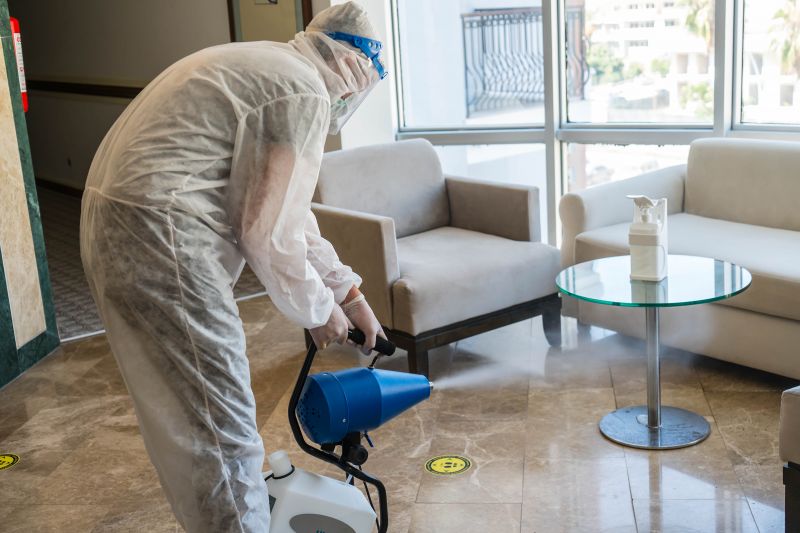Information on disinfecting for COVID-19

COVID-19 DISINFECTING: Knowing the why and how of it to make the best decision and ensure the best outcome for senior communities.
COVID-19 is everywhere: in the news, in people’s discussions, on everyone’s mind. A lot is being said from all corners of the media. In the face of all of this, businesses are reevaluating necessary protocols for keeping their environments safe. If you own or manage a senior living community, it is now more important than ever to get residents’ protection right for everyone’s sake. Seniors are by far the most vulnerable segment of society when it comes to COVID-19. But where to start? Here is some pertinent information to help you make the best possible decisions.
Basic cleaning is job one Whatever disinfecting process you ultimately choose, it will only be effective if the area is clean to begin with. All surfaces should be thoroughly cleaned with soap and water prior to being disinfected. Viruses and bacteria can easily be protected by dirt and other grime, requiring that surfaces be cleaned before any disinfectant is applied. Think of it as safeguarding your investment in disinfecting. Preparing surfaces by first cleaning them ensures the best possible protection for you, your staff and your residents once disinfecting is complete.
Which disinfecting process to choose once basic cleaning is complete There are a number of options to consider, all of which can have their appropriate uses depending on the situation.
- Disinfectant towel or wipe This works fine, l but only for a short-term solution. The downside is that as you wipe more and more, the wipe can get dirty (contaminates itself and becomes less and less effective). This works best for small, confined areas.
- Manual Disinfecting In this process, disinfectant is applied using spray bottles and micro-fiber cloths to all frequently touched areas such as:
- Entryways, door handles and push-plates
- Light switches and power outlets
- Handrails
- Countertops and drinking fountains
- Elevator buttons
- Restroom dispensers and faucets
- Phones, keyboards, etc.
- Manual disinfection is used after the cleaning cycle and is part of a standard cleaning procedure. This is applied only to areas that are frequently touched.
- ULV (Ultra Low Volume) Disinfectant Fogging Mist Again, basic cleaning of all surfaces must be completed prior to fogging. Areas that are high-risk, or have a suspected contamination or exposure to coronavirus, are a good candidate for employing a disinfectant fogging process. It saturates an entire room with a microbial disinfectant substance that can purify and remove pathogens (bacteria, viruses and fungi) from the air and surfaces in a room. ULV foggers produce smaller particles (10-50 microns) than standard foggers allowing the particles to remain suspended in the air longer which results in a broader distribution of the treated area. It moves with the air while settling, and thus, gets around and behind items—finds its way into all the little nooks and crannies.
Fogging requires proper gear (mask and respirator), and should only be performed by industry professionals using specifically formulized disinfectant solutions. Any areas being fogged should be sufficiently aired out prior to reopening for general use. If at risk for continued exposure, fogging should be done regularly. There are different types of fogging machines:
- Chemical foggers disperse a fine mist of disinfectant solution saturating the area. This is relatively fast, but harmful to breathe, requiring proper gear. Works well for the widest range of applications.
- Vaporized hydrogen peroxide (VHP) is used in medical or sensitive manufacturing settings where safe rooms are required. Though very efficient, the room must be dehumidified first and does not work with biofilms.
- Ozone fogging is a highly reactive compound produced at the point of use by passing air through a high-energy source such as UV light. The room must be humidified prior to service and must be cleared with fresh air after.
- Chlorine dioxide (CIO2) treatment is a quite safe option as the gas breaks down into harmless salts. It is easy to produce and leaves no residue. The drawback is that it is an unstable compound which must be generated on location and has rigid temperature and humidity parameters that can make it unstable for some uses.
- Ionization process passes air over ionizing tubes creating charged ions that seek out and neutralize naturally charged airborne microorganisms. This option produces long-lasting results and covers the largest surface area, but is less effective at treating all bacteria.
Foggers are increasingly being used for a variety of areas as concerns over COVID-19 and other viral or bacterial transmissions continue to rise. For the most effective outcome, fogging should be performed in enclosed areas that can be sealed off for a minimum of two hours.
- Electrostatic Spraying With this process, particles are positively charged as they are sprayed outward. Since most surfaces are negatively charged because they are naturally grounded, they attract the positively charged particles. This creates a more thorough and even coverage of the disinfectant. It covers the harder to reach surfaces than traditional wet spraying. The disinfectant will adhere to the surfaces once dried and remains there longer. Full PPE is required while applying. Though very effective, this process is quite costly, often running 3-4 times the cost of plain fogging.
These options as discussed are effective methods for disinfecting when used appropriately for particular environments and situations. Consider all options carefully to make the best choice for your senior care community and find some peace of mind for yourself, your employees and your residents.
Blog information provided by Walter Gheller of GMG Services.
For more information or service call: 612-434-7303 or visit their website.

